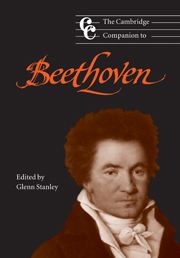Book contents
- Frontmatter
- Part I A professional portrait
- Part II Style and structure
- 4 “The spirit of Mozart from Haydn's hands”: Beethoven's musical inheritance
- 5 Phrase, period, theme
- 6 “The sense of an ending”: goal-directedness in Beethoven's music
- Part III Genres
- Part IV Reception
- Notes
- Selected further reading
- General index
- Index of Beethoven’s compositions and sketches
- Plate section
4 - “The spirit of Mozart from Haydn's hands”: Beethoven's musical inheritance
from Part II - Style and structure
Published online by Cambridge University Press: 28 September 2011
- Frontmatter
- Part I A professional portrait
- Part II Style and structure
- 4 “The spirit of Mozart from Haydn's hands”: Beethoven's musical inheritance
- 5 Phrase, period, theme
- 6 “The sense of an ending”: goal-directedness in Beethoven's music
- Part III Genres
- Part IV Reception
- Notes
- Selected further reading
- General index
- Index of Beethoven’s compositions and sketches
- Plate section
Summary
Open any textbook in music history or music appreciation and the problem of Beethoven's relation to music historiography becomes immediately apparent: is he Classical or Romantic or both or neither? Is he part of the Canonical Three of the Viennese Classical Style – Haydn, Mozart, Beethoven – or is he a chapter unto himself, as the One destined to inherit and transform, even liberate, the achievements of the Classical Duo? As Charles Rosen astutely pointed out, “it would appear as if our modern conception of the great triumvirate had been planned in advance by history”: Count Waldstein's entry in Beethoven's album, written in 1792 as the young composer left Bonn for Vienna, famously assured him that “You will receive the spirit of Mozart from the hands of Haydn.” This attractive phrase refers to the sense of lineage both conceptual and practical that places Beethoven in a musical culture already fully fledged in its genres and expressive possibilities. Mozart's premature death and the position of Haydn as Beethoven's teacher in Vienna left Beethoven perfectly placed to come into his inheritance. This chapter will examine some of the dominant elements in European music in the last few decades of the eighteenth century, and explore some of his methods of appropriating and personalizing the expressive language of Haydn and Mozart.
Oppositions
By 1790, observers of the musical scene could classify the genres and structures of music according to shared assumptions about their place in musical life and the level of sophistication of their audience. About Vienna we read of a broad division of the musical public into the more and less knowledgeable: audience members, including patrons, comprised “connoisseurs” and “amateurs,” while performers might be classed as “virtuosi” or “dilettanti” according to their skill. Music was performed in a range of venues from the grand and costly public theaters associated with courts (for example,Vienna’s Burgtheater) to the salons of the aristocracy and wealthier middle classes, from open-air gardens and coffee- [45] houses to private homes.
- Type
- Chapter
- Information
- The Cambridge Companion to Beethoven , pp. 43 - 63Publisher: Cambridge University PressPrint publication year: 2000



